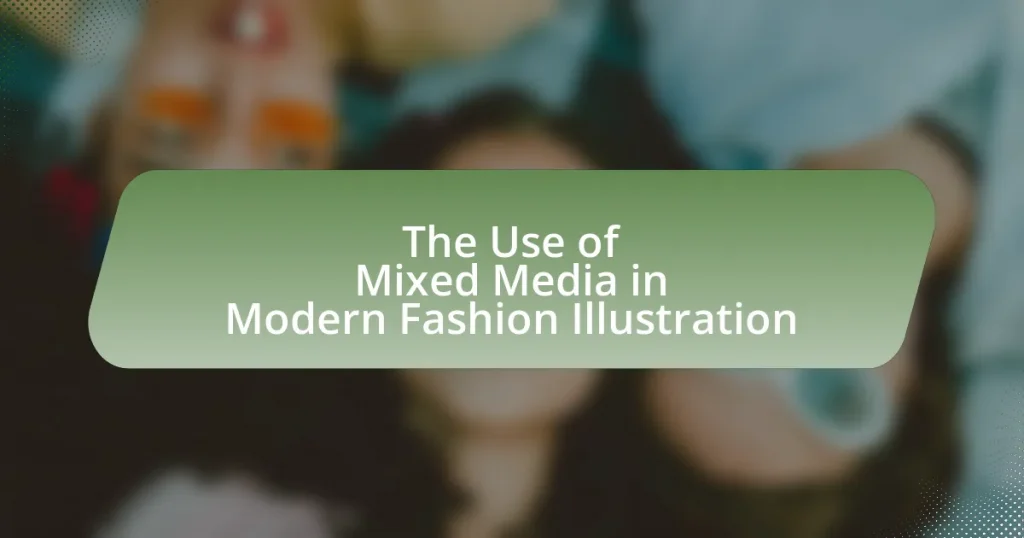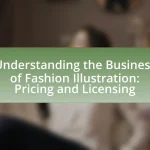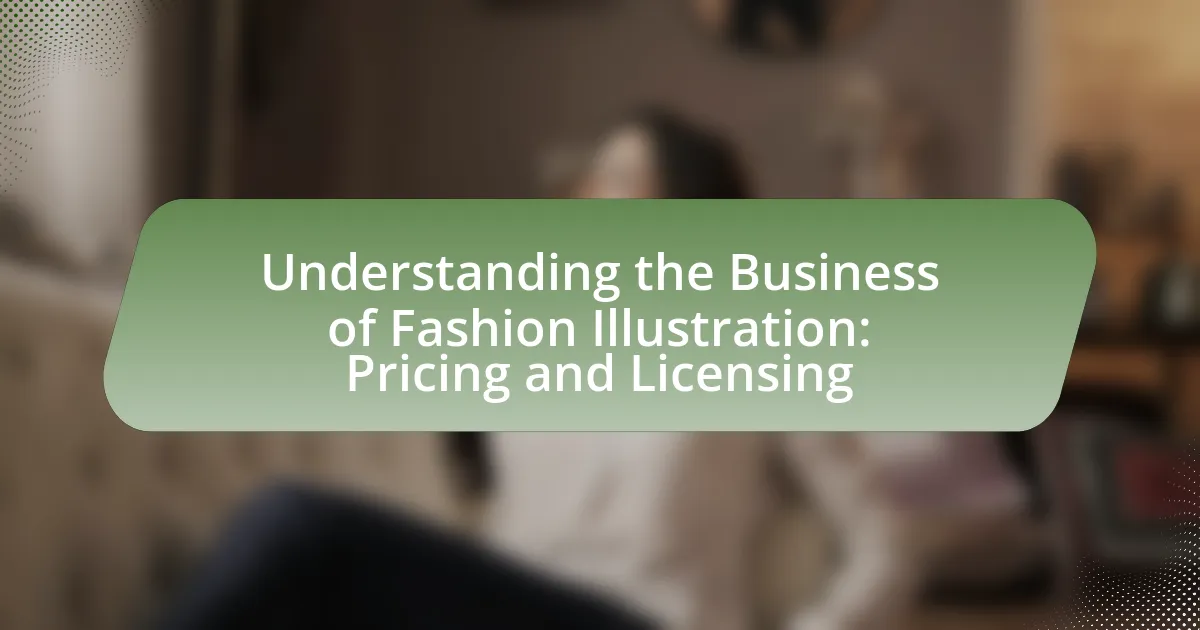The article explores the significant role of mixed media in modern fashion illustration, highlighting how artists combine various materials and techniques to enhance creativity and expression. It discusses the evolution of mixed media from traditional methods to the integration of digital tools, reflecting contemporary fashion’s complexity. Historical influences, popular techniques, and the challenges faced by artists are examined, along with best practices for creating cohesive and engaging illustrations. The article emphasizes the importance of mixed media in capturing the essence of modern fashion and the unique advantages it offers over traditional illustration methods.
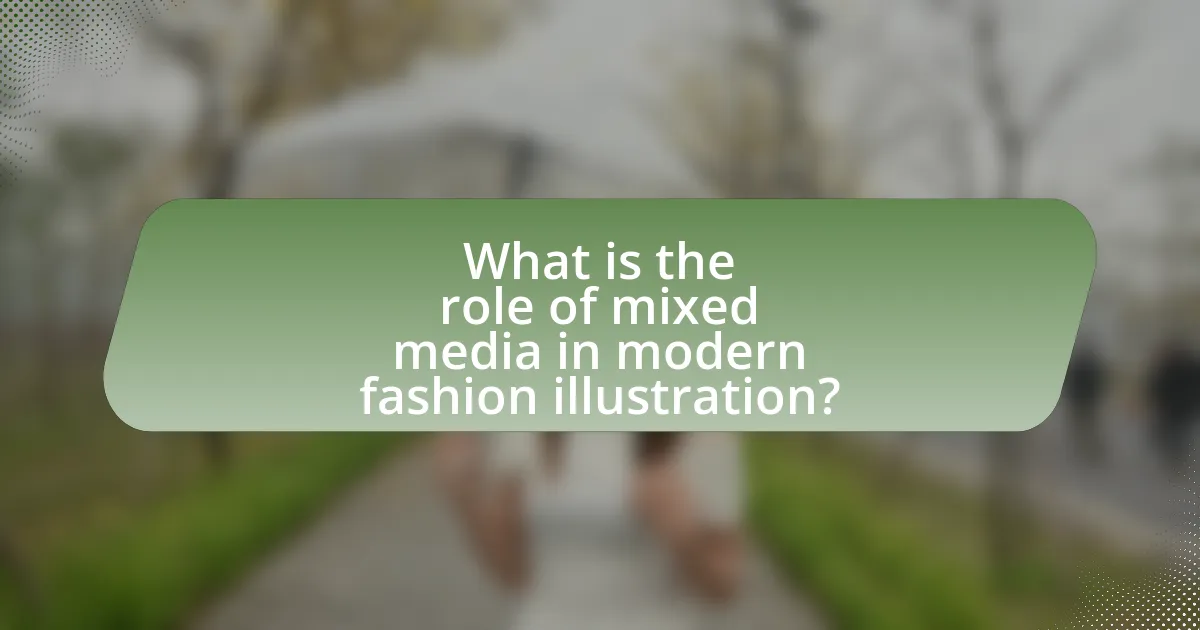
What is the role of mixed media in modern fashion illustration?
Mixed media plays a crucial role in modern fashion illustration by allowing artists to combine various materials and techniques, enhancing creativity and expression. This approach enables illustrators to create more dynamic and textured visuals, which can better convey the mood and style of fashion designs. For instance, the integration of digital tools with traditional methods, such as watercolor or collage, allows for innovative representations that resonate with contemporary audiences. The versatility of mixed media also reflects the diverse influences in fashion today, making illustrations more relatable and engaging.
How has mixed media evolved in the context of fashion illustration?
Mixed media in fashion illustration has evolved significantly from traditional techniques to incorporate digital elements and diverse materials. Initially, fashion illustrations primarily utilized watercolors, ink, and pencil, focusing on hand-drawn representations. However, the advent of digital technology in the late 20th century introduced software like Adobe Illustrator and Photoshop, allowing artists to blend traditional methods with digital tools. This evolution has led to a more dynamic and versatile approach, enabling illustrators to experiment with textures, colors, and styles that were previously difficult to achieve. For instance, contemporary fashion illustrators often combine photography, collage, and digital painting, creating layered visuals that reflect modern aesthetics and trends. This shift not only enhances creativity but also aligns with the fast-paced nature of the fashion industry, where quick adaptations and innovative designs are essential.
What historical influences have shaped the use of mixed media in fashion illustration?
The use of mixed media in fashion illustration has been shaped by several historical influences, including the evolution of artistic movements and technological advancements. The rise of modernism in the early 20th century encouraged artists to experiment with various materials and techniques, leading to the incorporation of collage and mixed media in fashion illustrations. Additionally, the introduction of photography as a medium in the 1920s allowed illustrators to blend photographic elements with traditional drawing, further expanding the scope of mixed media. The influence of pop art in the 1960s also played a significant role, as artists like Andy Warhol integrated commercial aesthetics into their work, inspiring fashion illustrators to adopt a more eclectic approach. These historical contexts demonstrate how artistic innovation and technological progress have continuously shaped the practice of mixed media in fashion illustration.
How do contemporary artists incorporate mixed media techniques?
Contemporary artists incorporate mixed media techniques by blending various materials and methods, such as painting, drawing, photography, and digital elements, to create multidimensional artworks. This approach allows artists to explore diverse textures and visual effects, enhancing the narrative and emotional depth of their pieces. For instance, artists like Kehinde Wiley combine traditional oil painting with photographic elements, creating a dialogue between classical and contemporary styles. Additionally, the use of mixed media in fashion illustration often includes collage techniques, where fabric swatches, printed materials, and hand-drawn elements are layered to produce dynamic representations of garments. This integration of different media not only reflects the complexity of modern fashion but also engages viewers through its tactile and visual richness.
Why is mixed media significant in modern fashion illustration?
Mixed media is significant in modern fashion illustration because it allows artists to combine various materials and techniques, enhancing creativity and expression. This approach enables illustrators to create more dynamic and visually engaging works that reflect contemporary fashion’s complexity. For instance, the integration of digital tools with traditional methods, such as watercolor or collage, has become prevalent, allowing for innovative textures and effects that resonate with current trends. This versatility not only broadens the artistic possibilities but also aligns with the fashion industry’s emphasis on individuality and uniqueness, making mixed media a vital component in capturing the essence of modern fashion.
What advantages does mixed media offer over traditional illustration methods?
Mixed media offers greater versatility and creativity compared to traditional illustration methods. This approach allows artists to combine various materials such as paint, ink, fabric, and digital elements, resulting in unique textures and visual effects that cannot be achieved with a single medium. For instance, a study published in the Journal of Visual Arts Practice highlights that mixed media techniques can enhance emotional expression and narrative depth in artwork, making it more engaging for viewers. Additionally, the integration of different materials can lead to innovative styles and techniques, fostering artistic experimentation and pushing the boundaries of conventional illustration.
How does mixed media enhance creativity and expression in fashion illustration?
Mixed media enhances creativity and expression in fashion illustration by allowing artists to combine various materials and techniques, resulting in unique visual outcomes. This approach enables illustrators to experiment with textures, colors, and forms, which can lead to more dynamic and innovative representations of fashion concepts. For instance, the integration of digital tools with traditional methods, such as watercolor or collage, can create depth and complexity that single media cannot achieve. Studies have shown that artists who utilize mixed media often report increased satisfaction and a broader range of creative ideas, as the combination of different mediums stimulates new ways of thinking and visual storytelling.
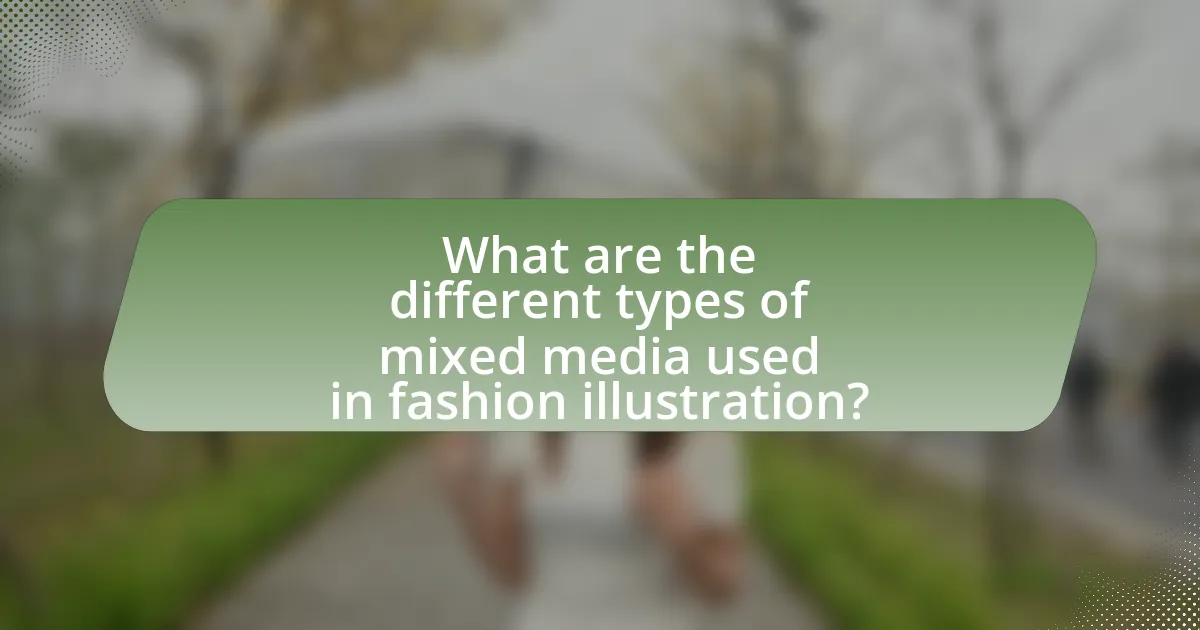
What are the different types of mixed media used in fashion illustration?
Different types of mixed media used in fashion illustration include watercolor, ink, digital tools, collage, and pastels. Watercolor provides fluidity and softness, while ink adds precision and boldness. Digital tools allow for versatility and easy manipulation of designs. Collage incorporates various materials, enhancing texture and depth, and pastels offer vibrant colors and a unique finish. Each medium contributes distinct characteristics that enrich the overall aesthetic of fashion illustrations.
What materials are commonly used in mixed media fashion illustrations?
Common materials used in mixed media fashion illustrations include watercolor, ink, colored pencils, markers, and collage elements such as fabric and paper. These materials allow artists to create depth and texture, enhancing the visual appeal of their illustrations. For instance, watercolor provides a fluid quality, while ink adds sharpness and detail. The combination of these materials enables artists to experiment with various techniques, resulting in unique and dynamic representations of fashion.
How do different materials affect the final outcome of an illustration?
Different materials significantly influence the final outcome of an illustration by altering texture, color saturation, and overall visual impact. For instance, using watercolors can create soft, translucent effects, while acrylics provide vibrant colors and a thicker texture. The choice of paper also plays a crucial role; rough surfaces can enhance the depth of pencil or charcoal illustrations, whereas smooth surfaces are better suited for ink or digital prints. Research indicates that mixed media approaches, which combine various materials, can lead to more dynamic and engaging illustrations, as evidenced by the work of contemporary artists who utilize diverse materials to achieve unique visual narratives.
What role do digital tools play in mixed media fashion illustration?
Digital tools are essential in mixed media fashion illustration as they enhance creativity and streamline the design process. These tools allow artists to combine traditional techniques with digital elements, enabling greater flexibility in experimentation and execution. For instance, software like Adobe Photoshop and Procreate facilitates the layering of textures, colors, and patterns, which can be integrated with hand-drawn sketches. This integration not only saves time but also allows for precise adjustments and the ability to easily share and collaborate on designs. The use of digital tools has become a standard practice in the industry, as evidenced by the increasing prevalence of digital illustrations in fashion magazines and online platforms, showcasing the effectiveness of these tools in modern fashion illustration.
How do artists combine various techniques in mixed media fashion illustration?
Artists combine various techniques in mixed media fashion illustration by integrating diverse materials and methods, such as drawing, painting, collage, and digital elements. This approach allows for the creation of unique textures and visual effects that enhance the overall aesthetic of the illustration. For instance, an artist may use watercolor for the base layer, then overlay it with ink or markers for detailing, and finally incorporate fabric swatches or digital graphics to add depth and dimension. This combination not only showcases the artist’s versatility but also reflects contemporary trends in fashion, where mixed media is increasingly embraced for its innovative potential.
What are some popular techniques used in mixed media fashion illustration?
Popular techniques used in mixed media fashion illustration include collage, watercolor, digital manipulation, and ink drawing. Collage involves combining various materials such as fabric swatches, magazine cutouts, and textured papers to create layered visuals that enhance the illustration’s depth. Watercolor adds fluidity and vibrant color, allowing for expressive and dynamic representations of fashion designs. Digital manipulation utilizes software to blend traditional illustrations with digital elements, enabling artists to experiment with colors and textures seamlessly. Ink drawing provides bold outlines and intricate details, often serving as a foundation for other mixed media techniques. These methods collectively enrich the visual storytelling in fashion illustration, making it more engaging and versatile.
How do artists achieve balance and harmony in their mixed media works?
Artists achieve balance and harmony in their mixed media works by carefully selecting and combining various materials and techniques to create a cohesive visual experience. They often consider elements such as color, texture, and composition, ensuring that each component complements the others. For instance, the use of contrasting textures, like smooth paint against rough fabric, can create visual interest while maintaining harmony through a unified color palette. Additionally, artists may employ principles of design, such as symmetry or asymmetry, to guide the viewer’s eye and establish a sense of equilibrium within the artwork. This approach is supported by the fact that successful mixed media pieces often evoke emotional responses, indicating that balance and harmony are effectively achieved.
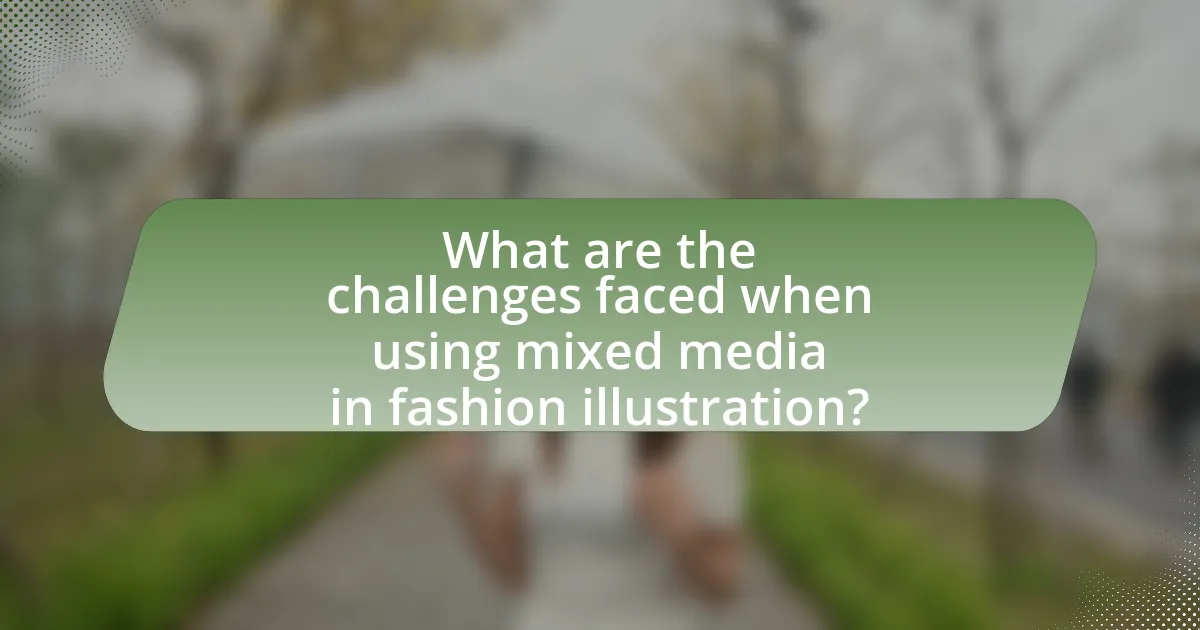
What are the challenges faced when using mixed media in fashion illustration?
The challenges faced when using mixed media in fashion illustration include the complexity of integrating various materials, the potential for inconsistency in style, and the difficulty in achieving a cohesive final product. Integrating different materials, such as paint, fabric, and digital elements, can lead to technical issues, such as drying times and compatibility of mediums. Inconsistency in style may arise as artists navigate the distinct characteristics of each medium, which can result in a disjointed visual narrative. Achieving a cohesive final product requires careful planning and experimentation, often leading to increased time and effort in the creative process.
What common obstacles do artists encounter with mixed media techniques?
Artists encounter several common obstacles with mixed media techniques, including material compatibility, drying times, and the complexity of layering. Material compatibility issues arise when different mediums do not adhere well to each other, leading to unexpected results or damage to the artwork. For instance, oil-based paints may not mix well with water-based mediums, causing separation or peeling. Additionally, varying drying times can complicate the creative process; some materials may dry too quickly, while others take longer, disrupting the artist’s workflow. The complexity of layering techniques also presents challenges, as artists must carefully consider how each layer interacts with the others to achieve the desired effect. These obstacles can hinder the creative process and impact the final outcome of the artwork.
How can artists overcome these challenges in their work?
Artists can overcome challenges in their work by embracing experimentation with various materials and techniques. By integrating different media, such as digital tools alongside traditional methods, artists can enhance their creative expression and adaptability. Research indicates that artists who diversify their skill sets and explore unconventional combinations often produce more innovative and compelling work, as seen in the rise of mixed media in modern fashion illustration, which allows for unique visual narratives and styles.
What are the risks of using mixed media in fashion illustration?
The risks of using mixed media in fashion illustration include potential inconsistency in style, difficulty in achieving a cohesive visual narrative, and challenges in reproduction quality. Inconsistency arises when various materials and techniques are combined, leading to a disjointed appearance that may confuse the viewer. Achieving a cohesive visual narrative can be complicated, as different media may convey contrasting messages or aesthetics. Additionally, reproduction quality can suffer, as certain mixed media elements may not translate well in print or digital formats, resulting in loss of detail or color fidelity. These factors can undermine the effectiveness of the illustration in conveying the intended fashion concept.
How can artists effectively showcase their mixed media fashion illustrations?
Artists can effectively showcase their mixed media fashion illustrations by utilizing a combination of digital platforms and physical exhibitions. Digital platforms, such as social media and personal websites, allow artists to reach a broader audience and display their work in high resolution, enhancing visibility. For instance, Instagram’s visual-centric format is particularly effective for sharing mixed media art, as it allows for engaging storytelling through posts and stories.
Physical exhibitions, such as gallery shows or pop-up events, provide an immersive experience where viewers can appreciate the texture and depth of mixed media works firsthand. According to a study by the National Endowment for the Arts, exhibitions can significantly increase public engagement with art, leading to higher appreciation and understanding of the medium.
Additionally, artists can create video content that showcases their creative process, which not only highlights their techniques but also engages viewers on a personal level. This approach has been shown to enhance audience connection and interest in the artist’s work.
What platforms are best for displaying mixed media fashion illustrations?
The best platforms for displaying mixed media fashion illustrations include Instagram, Behance, and Pinterest. Instagram allows artists to showcase their work visually and engage with a large audience, making it ideal for fashion illustrations. Behance provides a professional space for creatives to present their portfolios, enabling detailed project descriptions and high-quality images. Pinterest serves as a visual discovery tool, where users can curate boards and share inspiration, making it effective for reaching fashion enthusiasts. Each platform supports high-resolution images and community interaction, enhancing visibility and engagement for mixed media fashion illustrations.
How can social media influence the reception of mixed media fashion art?
Social media significantly influences the reception of mixed media fashion art by providing a platform for immediate visibility and audience engagement. This visibility allows artists to showcase their work to a global audience, leading to increased recognition and potential sales. For instance, platforms like Instagram and Pinterest enable artists to share their mixed media creations, which can result in viral trends and collaborations. According to a study by the Pew Research Center, 72% of adults use social media, indicating a vast audience that can interact with and respond to mixed media fashion art. This interaction often shapes public perception and can elevate the status of certain artists or styles within the fashion community.
What best practices should artists follow when creating mixed media fashion illustrations?
Artists should prioritize experimentation and layering techniques when creating mixed media fashion illustrations. This approach allows for the integration of various materials, such as watercolor, ink, and fabric, which can enhance texture and depth in the artwork. Additionally, artists should maintain a cohesive color palette to ensure harmony among the different media used, as this can significantly impact the overall aesthetic.
Furthermore, understanding the properties of each medium is crucial; for instance, knowing how water-based paints interact with paper can prevent unwanted bleeding or smudging. Artists should also consider the composition and balance of elements within the illustration, as a well-structured layout can draw the viewer’s eye effectively.
Lastly, documenting the process can provide insights for future projects and help artists refine their techniques over time. These best practices are supported by the growing trend in fashion illustration that emphasizes innovation and personal style, as seen in contemporary works showcased in fashion magazines and art exhibitions.
How can artists develop their unique style using mixed media?
Artists can develop their unique style using mixed media by experimenting with various materials and techniques to create distinctive visual expressions. This approach allows artists to combine traditional mediums, such as paint and pencil, with unconventional materials like fabric, paper, or digital elements, fostering innovation and personal expression. For instance, artists like Robert Rauschenberg and Jasper Johns utilized mixed media to challenge conventional boundaries, leading to the emergence of new artistic styles. By continuously exploring and integrating diverse materials, artists can cultivate a signature style that reflects their individual perspectives and creativity.
What tips can help artists improve their mixed media techniques?
Artists can improve their mixed media techniques by experimenting with various materials and layering methods. Engaging with different mediums, such as acrylics, watercolors, and collage elements, allows artists to discover unique combinations that enhance their work. Additionally, studying the techniques of established mixed media artists can provide valuable insights and inspiration. For instance, artists like Robert Rauschenberg and Jasper Johns have effectively used layering and juxtaposition to create depth and interest in their pieces. Practicing these techniques regularly can lead to improved skills and a more personal artistic style.
